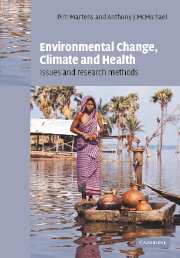Book contents
- Frontmatter
- Contents
- List of contributors
- Foreword
- 1 Global environmental changes: anticipating and assessing risks to health
- 2 Historical connections between climate, medical thought and human health
- 3 The contribution of global environmental factors to ill-health
- 4 Surprise, nonlinearity and complex behaviour
- 5 Epidemiological and impacts assessment methods
- 6 Retrospective studies: analogue approaches to describing climate variability and health
- 7 Detecting the infectious disease consequences of climate change and extreme weather events
- 8 Integrated Assessment modelling of human health impacts
- 9 Remote sensing, GIS and spatial statistics: powerful tools for landscape epidemiology
- 10 Monitoring the health impacts of global climate change
- 11 Epidemiology, environmental health and global change
- 12 Dealing with scientific uncertainties
- Index
- Plate section
- References
7 - Detecting the infectious disease consequences of climate change and extreme weather events
Published online by Cambridge University Press: 28 July 2009
- Frontmatter
- Contents
- List of contributors
- Foreword
- 1 Global environmental changes: anticipating and assessing risks to health
- 2 Historical connections between climate, medical thought and human health
- 3 The contribution of global environmental factors to ill-health
- 4 Surprise, nonlinearity and complex behaviour
- 5 Epidemiological and impacts assessment methods
- 6 Retrospective studies: analogue approaches to describing climate variability and health
- 7 Detecting the infectious disease consequences of climate change and extreme weather events
- 8 Integrated Assessment modelling of human health impacts
- 9 Remote sensing, GIS and spatial statistics: powerful tools for landscape epidemiology
- 10 Monitoring the health impacts of global climate change
- 11 Epidemiology, environmental health and global change
- 12 Dealing with scientific uncertainties
- Index
- Plate section
- References
Summary
Introduction
According to the World Health Organization (WHO, 1996) 30 infectious diseases new to medicine emerged between 1976 and 1996. Included are HIV/AIDS, Ebola, Lyme disease, Legionnaires' disease, toxic Escherichia coli, a new hantavirus, a new strain of cholera and a rash of rapidly evolving antibiotic-resistant organisms. In addition, there has been a resurgence and redistribution of several old diseases on a global scale; for example, malaria and dengue (“breakbone”) fever carried by (vectored by) mosquitoes. The factors influencing this lability of infectious diseases are many and varied. They include urbanization, increased human mobility, long-distance trade, changing land-use patterns, drug abuse and sexual behaviours, the rise of antibiotic resistance, the decline of public health infrastructure in many countries, and a quarter century of predominantly anthropogenic climate change. This complex mix of potential influences means, of course, that the scientific task of attributing causation is difficult. This chapter discusses the types of evidence relevant to the detection of changes in infectious disease occurrence in response to climatic variations and trends.
Arthropods such as mosquitoes and ticks are extremely sensitive to climate. Throughout the past century public health researchers have understood that climate circumscribes the distribution of mosquito-borne diseases, while weather affects the timing and intensity of outbreaks (Gill, 1920, 1921; Dobson& Carper, 1993). Paleoclimatic data (Elias, 1994) demonstrate that geographical shifts of beetles have been closely associated with changes in climate.
- Type
- Chapter
- Information
- Environmental Change, Climate and HealthIssues and Research Methods, pp. 172 - 196Publisher: Cambridge University PressPrint publication year: 2002
References
- 5
- Cited by



